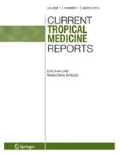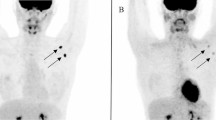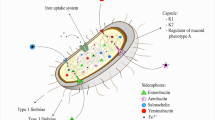Abstract
Purpose of Review
This is to highlight the relationship between the morphologically identical pathogenic and nonpathogenic amoebae commonly recovered from human feces. Microscopy does not differentiate pathogenic from nonpathogenic strains. The problem of treat or do not treat infection depends on whether it is pathogenic or not, and whether reported in endemic or non-endemic country.
Recent Findings
Prevalence of amoebiasis differs greatly in different areas of the world reaching up to 50%. Easy diagnosis of amoebiasis now depends on the use of immunochromatography and/or PCR. Multiplex PCR can differentiate the pathogenic amoebae. The phylogenetic analysis of the nonpathogenic E. dispar showed a variety of genotypes. A pathogenic E. dispar genotype was isolated from an amebic liver abscess.
Summary
E. histolytica is now easily identified in laboratories, saving time and effort in diagnosis and management of infection. Phylogenetic analysis of E. histolytica and E. dispar and studying the detected genotypes can explain the big variation in pathogenicity in humans.

Similar content being viewed by others
References
Papers of particular interest, published recently, have been highlighted as: • Of importance •• Of major importance
• Fotedar R, Stark D, Beebe N, Marriott D, Ellis J, Harkness J. Laboratory diagnostic techniques for Entamoeba species. ClinMicrobiolRev. 2007;20(3):511–32. A descriptive review for diagnosis of amebiasis.
Romano N, Fakhrurrazi A, Yvonne A, Jamaiah I, Rohela M. Differentiating Entamoeba histolytica, Entamoeba dispar and Entamoeba moshkovskii using nested polymerase chain reaction (PCR) in rural communities in Malaysia. Parasites and Vectors. 2010;5:187.
Tengku SA, Norhayati M. Public health and clinical importance of amoebiasis in Malaysia: a review. Trop Biomed. 2011;28(2):194–222.
Ouattara M, N’Guéssan NA, Yapi A, N’Goran EK. Prevalence and spatial distribution of Entamoeba histolytica/dispar and Giardia lamblia among school children in Agboville area (Côte d’Ivoire). PLoS Negl Trop Dis. 2010;4(2):10.1371.
World Health Organization. Amebiasis. Weekly Epidermiol Rec. 1997;72:97–100.
Slack A. Parasitic cases of prolonged diarrhea in travellers. Diagnosis and management. Reprod Health. 2012;41(10):782–6.
Lo YC, Ji DD, Hung CC. Prevalent and incident HIV diagnosis among Entamoeba histolytica-infected adult males: a changing epidemiology associated with sexual transmission-Taiwan, 2006-2013. PLoS Negl Trop Dis. 2014;8(10), e3222.
Elsdon-Dew R. Amoebiasis: its meaning and diagnosis. Review article. S.A. Medical Journal. 1969;19:483–6.
Schaudinn F. Arb Gesundh-Amte (Berl). 1903;19:547.
Elmassian, M. Zbl. Bakl. 1. Abt. Orig. 1909: 52, 335.
Walker EL. The parasitic Amebae of the intestinal tract of man and other animals. J Med Res. 1908;17(4):379–460.
Walker EL, Sellards AW. Experimental entamebic dysenrery. Philip J Sci. 1913;8:253–331.
Wenyon, C. M. and O’Connor, F. W. (1917): J. Roy. Army Med. Cps., 28, I, 151, 346, 461, 557 and 686.
Dobell C. The amebas living in man. A zoological monograph. London: Bale, Sons and Danielsson, Ltd; 1919. p. 155.
Brumpt E. Differentiation of human intestinal amoebae with four-nucleated cysts. Trans R Soc Trop Med Hyg. 1928;22:101–14. Discussion pp. 115-124.
Pinella AE, Lopez MC, Viasus DF. History of Entamoeba histolytica Protozoan. Rev Med Chil. 2008;136(1):118–24.
Diamond LS, Clark CG. A redescription of Entamoeba histolytica Schaudinn, 1903 (emended Walker, 1911) separating it from Entamoeba dispar Brumpt. J Eukaryot Microbiol. 1993;1925(40):340–4.
Tshalaia LE. On a species of Entamoeba detected in a sewage effluents. (in Russian). Med Parazit (Moscow). 1941;10:244–52.
Sodeman WA. Intestinal protozoa, Amebas. Chapter 79. In: Baron S, editor. Medical microbiology. 4th ed. Galveston: University of Texas Medical Branch of Galviston; 1996.
Clark CG, Espinosa-Cantellano M, Bhattacharya A. Entamoeba histolytica: an overview of the biology of the organism. In: Ravdin JI, editor. Amebiasis. London, United Kingdom: Imperial College Press; 2000. p. p. 145.
Garcia LS, Bruckner DA. Diagnostic medical parasitology. 3rd ed. Washington, D.C: ASM Press; 1997.
Katz M, Despammier DD, Gwadz RW. Parasitic diseases. New York, N.Y.: Springer Verlag; 1989.
Beaver PC, Jung RC, Cupp EW. Amebae inhabiting the Alimentary Canal. In Clinical Parasitology, 9th edition, Lea & Febiger, Philadelphia. 1984; 101-148.
Houpt E, Hung C, Petri W. Entamoeba histolytica (amebiasis). Infectious Disease and Antimicrobial Agents. 2016: http://www.antimicrobe.org/new/b137.
WHO. Health conditions in the occupied Palestinian territory, including east Jerusalem, and in the occupied Syrian Golan. Sixty-second World Health Assembly, provisional agenda item14. May 2009.
Zibaei M, Firooz F, Azargoon A. Infantile Amoebiasis: A Case Report. Case Reports in Infectious Diseases. Volume 2012 (2012), Article ID 614398, 3 pages doi:10.1155/2012/614398
Freedman DO, Weld LH, Kozarsky PE, Fisk T, Robins R, von Sonnenburg F, et al. Spectrum of disease and relation to place of exposure among all returned travellers. N Engl J Med. 2006;354(2):119–30.
Gunther J, Shafir S, Bristow B, Sorvillo F. Amoebiasis-related mortality among United States residents, 1990-2007. Am J Trop Med Hyg. 2011;85(6):1038–40.
Caballero-Salcedo A, Viveros-Rogel M, Salvatierra B, Tapia-Conyer R, Sepulveda-Amor J, Gutierrez G, et al. Seroepidemiology of amebiasis in Mexico. Am J Trop Med Hyg. 1994;50(4):412–9.
Peruzzi S, Gorrini C, Piccolo G, Calderaro A, Dettori G, Chezzi C. Prevalence of intestinal parasites in the area of Parma during the year 2005. Acta Biomed. 2006;77:147–15.
Masucci L, Graffeo R, Bani S, Bugali F, Boccia S, Nicolotti N. Intestinal parasites isolated in a large teaching hospital, Italy, 1 May 2006 to 31 December 2008. Euro Surveill. 2011;16:19–25.
Belli A, Coppolab MG, Petrullob LP, Lettieric G, Palumboc C, Dell’Isolac C, et al. The current spectrum and prevalence of intestinal parasitosis in Campania region of southern Italy and their relationship with migration from endemic countries. Int J Infect Dis. 2014;29:42–7.
Babic E, Bevanda M, Mimica M, Karin M, Volaric M, Boqut A, et al. Prevalence of amebiasis in inflammatory bowel disease in University Clinical Hospital Mostar. Springer plus. 2016;5(1):1586.
Koksal F, Baslanti I, Samasti M. A retrospective evaluation of the prevalence of intestinal parasites in Istanbul, Turkey. Türk Parazitol Derg. 2010;34(3):166–71.
Malatyali E, Ozcelik S, Celiksoz A. The investigation of Entamoeba histolytica prevalence in some villages of Sivas by ELISA method. Turkiye Parazitol Derg. 2011;35:6–9.
Alver O, Heper Y, Erkan I, Akalin H, Tore O. Prevalence and assessment of enzyme-linked immunosorbent assays (ELIsA) and three microscopic methods in the diagnosis of Entamoeba histolytica/dispar. Afr J Microbiol Res. 2011;5(12):1443–9.
Naous A, Naja Z, Zaatari N, Kamel R, Rajab M. Intestinal amebiasis, a concerning cause of acute gastroenteritis among hospitalized children. N Am J Med Sci. 2013;5(12):689–98.
Osman M, El Safadi D, Cian A, Benamrouz S, Nourrisson C, Poirier P, et al. Prevalence and risk factors for intestinal protozoan infections with Cryptosporidium, Giardia, Blastocystis and Dientamoeba among schoolchildren in Tripoli, Lebanon. PLoS Negl Trop Dis. 2016;10(3), e0004496. doi:10.1371/journal.pntd.0004496.
Abdel-Dayem M., Al Zou’bi R., Bani Hani R., Amer ZS. Microbiological and Parasitological investigation among food handlers in hotels in the Dead Sea area, Jordan. Journal of Microbiology, Immunology and Infection (29 June 2013); doi:10.1016/jmii.2013.06.001
Nimri LF. Cyclospora cayetanensis and other intestinal parasites associated with diarrhea in a rural area of Jordan. Int Microbiol. 2003;6:131. doi:10.1007/s10123-003-0121-4.
Chazal AM, Adi HK. The prevalence of intestinal parasites in Amman, Jordan. Bull Pharm Sci, Assuit Univ. 2007;30:335–40.
Ismail Y. Prevalence of parasitic contamination in salad vegetables collected from supermarkets and street vendors in Amman and Baqa’a – Jordan. Pol J Microbiol. 2016;65(2):1204480.
Alhindi AI, Al-Louh M. Trends of intestinal parasites prevalence in the Gaza Strip, 1998-2007: the use of government health records. TurkJMed Sci. 2013;43:65–595.
Al LN, Elyazji M, Al-Haddad R, Ridwan F. Prevalence of enteric pathogen-associated community gastroenteritis among kindergarten children in Gaza. J Biomed Res. 2015;29(1):61–8.
Stanley Jr SL. Amoebiasis. Lancet. 2003;361(9362):1025–34.
Banisch DM, El-Badry A, Klinnert JV, Ignatius R, El-Dib N. Simultaneous detection of Entamoeba histolytica/dispar, Giardia duodenalis and cryptosporidia by immunochromatographic assay in stool samples from patients living in greater Cairo Region, Egypt. World J. of Microbiol, and. Biotechnol. 2015;31(8):1251–8.
Ibrahim SS, El-Matarawy OM, Ghieth MA, Abu Sarea EY, El-Badry AA. Copro prevalence and estimated risk of Entamoeba histolytica in diarrheic patients at BeniSuef, Egypt. World J Microbiol Biotechnol. 2015;3(2):385–90.
Mohammad KA. Detection of human intestinal protozoa by using multiplex allele specific polymerase chain reaction (MAS-PCR) in New Damietta City. ZUMJ. 2013;19(6):556–68.
Eassa SM, Abd El-Wahab EW, Lotfi SE, El Masry SA, Shatat HZ, Kotkat AM. Risk factors associated with parasitic infection among municipality solid-waste workers in an Egyptian community. J Parasitol. 2016;102(2):214–21.
Ghenghesh KS., Ghanghish K., BenDarif ET., Shembesh K, and Franka E. Prevalence of Entamoeba histolytica, Giardia Lamblia and Cryptosporidium Spp. In Libya: 2000-2015. Libyan J Med 2016, 11: 32088 - doi:10.3402/ljm.v11.32088
El Ammari NE, Nair GA. Critical evaluation of the intestinal protozoan parasites among Libyan and other African residents of Al-Khoms, Libya. Journal of Entomology and Zoology Studies. 2015;3(2):42–6.
Ben AS, Aoun K, Maamouri N, Ben AR, Bourtabine A. Short report: first molecular identification of Entamoeba moshkovskii in human stool samples in Tunisia. Am J Trop Med Hyg. 2008;79(5):706–70.
El Mezouari E, Belhamri N, Lamrani HA, Kaddouri M, Zyani M, Qacif H, et al. Intestinal parasitic infections in adults in Marrakech: review of 7 years intestinal parasitic in adult at Marrakech: review of 7 years. Journal of Applied Science And Research. 2014;2(4):18–24.
Rojo S, Fernandez E, Balado C, Dominguez J, Morilla A, Perez F, et al. Geographic distribution of Entamoeba histolytica and Entamoeba dispar in immigrant population in Spain. Barcelona, Spain: European Congress of Clinical Microbiology and Infectious Diseases; 2014. p. 10–3.
French agency for food, environmental and occupational health and safety. Data sheet on foodborne biological hazards/Entamoeba histolytica, E. histolytica/E. dispar. January 2011. https://www.anses.fr/…/french-agency-food-environmental-and-occupational health and safety
Thellier M., Bart-Delabesse E., Poupon MC., Faussart A. Human intestinal amoebiasis revisited: pathogenic Entamoeba histolytica is less common than non pathogenic Entamoeba dispar. La Lettre de l’Infectiologue –Septembre-Octobre 2007; Tome XXII - n° 5
Leishout L, Verweij JJ. Newer diagnostic approaches to intestinal protozoa. Curr Opin Infect Dis. 2010;23:488–93.
Stensvold RC, Nielsen HV. Comparison of microscopy and PCR for detection of intestinal parasites in Danish patients supports an intensive for molecular screening platforms. JClin Microbiol. 2012;25(2):450–1.
Ravdin JI, Jackson TF, Petri Jr WA, Murphy CF, Ungar BL, Gathiram V, et al. Association of serum antibodies to adherence lectin with invasive amebiasis and asymptomatic infection with pathogenic Entamoeba histolytica. J Infect Dis. 1990;162:768–72.
Ximénez C, Cerritos R, Rojas L, Dolabella S, Morán P, Shibayama M, et al. Human amebiasis: breaking the paradigm? Int J Environ Res Public Health. 2010;7(3):1105–20.
Haque R, Mondal D, Duggal P, Kabir M, Roy S, Farr B, et al. Entamoeba histolytica infection in children and protection from subsequent amebiasis. Infect Immun. 2006;74(2):904–9.
•• Dhawan V. Amebiasis: Background, Pathophysiology, Etiology. http://emedicine.medscape.com/article/212029-overview. March 24 2016. A comprehensive review on amebiasis.
Bowley DM, Loveland J, Omar T, Pitcher GJ. Human immunodeficiency virus infection and amebiasis. Pediatr Infect Dis J. 2006;25(12):1192–3.
Brindicci G, Picciarelli C, Fumarola L, Carbonara S, Stano F, Ciracì E, et al. Amoebic hepatic abscesses in an HIV positive patient. AIDS Patient Care STDs. 2006;20(9):606–11.
Chen Y, Zhang Y, Yang B, Qi T, Lu H, Cheng X, et al. Seroprevalence of Entamoeba histolytica infection in HIV infected patients in China. Am J Trop Med Hyg. 2007;77(5):825–8.
Hsu MS, Hsieh SM, Chen MY, Hung CC, Chang SC. Association between amebic liver abscess and human immunodeficiency virus infection in Taiwanese subjects. BMC Infect Dis. 2008;8:48.
Park WB, Choe PG, Jo JH, Kim SH, Bang JH, Kim HB, et al. Amebic liver abscess in HIV infected patients, Republic of Korea. Emerg Infect Dis. 2007;13(3):516–7.
Karp CL, Auwaerter PG. Coinfection with HIV and tropical infectious diseases. I. Protozoal pathogens. Clin Infect Dis. 2007;45(9):1208–13.
Hung CC, Ji DD, Sun HY, Lee YT, Hsu SY, Chang SY, et al. Increased risk for Entamoeba histolytica infection and invasive amebiasis in HIV seropositive men who have sex with men in Taiwan. PLoS Negl Trop Dis. 2008;2(2):175.
Petri Jr WA, Haque R. Entamoeba species, including amebic colitis and liver abscess. In: Bennett JE, Dolin R, Mandell GL, editors. Mandell, Douglas, and Bennett’s principles and practice of infectious diseases. 8th ed. Philadelphia: Elsevier Saunders; 2014. p. 274.
Maltz G, Knauer CM. Amebic liver abscess: a 15-year experience. Am J Gastroenterol. 1991;86:704–10.
Anesi JA, Gluckman S. Amebic liver abscess, review. Clinical liver disease. A Multimeria Review Journal. 2015;6(2):41–3.
Hesse AAJ, Nouri AN, Hassan HS, Hashish AA. Parasitic infestations requiring surgical intervensions. Semin Pediatr Surg. 2012;21(2):142–50.
Dolabella SS, Serrano-Luna J, Navarro-Garcia F, Cerritos R, Ximenez C, Galvan-Moroyoqui JM, et al. Amoebic liver abscess production by Entamoeba dispar. Ann Hepatol. 2012;11(1):107–17.
Fernandes H, D’Souza CR, Swethadri GK, Naik CN. Ameboma of the colon with amebic liver abscess mimicking metastatic colon cancer. Indian J Pathol Microbiol. 2009;52(2):228–30.
Zapata L, Flores R, Jurado JJ, Hernández N, Altamirano J. Success of medical therapy in a rare case of cecal ameboma. El éxito del tratamiento médico en un raro caso de ameboma cecal. Rev Gastroenterol Mex. 2011;76:55–9.
Lin C, Kao K. Ameboma: a colon carcinoma-like lesion in a coloscopy finding. Case Rep Gastroenterol. 2013;7(3):438–41.
Majeed SK, Ghazanfar A, Ashraf J. Caecal amoeboma simulating malignant neoplasia, ileocaecal tuberculosis and Crohn’s disease. J Coll Physicians Surg Pak. 2003;13:116–7.
AbdAlla MD, ElHawey AM, Ravdin JI. Use of an enzyme linked-immunosorbent assay to detect anti-adherence protein antibodies in sera of patients with invasive amebiasis in Cairo, Egypt. Am J Trop Med Hyg. 1992;47:800–4.
Haque R, Mollah NU, Ali IK, Alam K, Eubanks A, Lyerly D, et al. Diagnosis of amebic liver abscess and intestinal infection with the Tech Lab Entamoeba histolytica II antigen detection and antibody tests. J Clin Microbiol. 2000;38(9):323–59.
Tanyuksel M, Petri Jr WA. Laboratory diagnosis of amebiasis. Clin Microbiol Rev. 2003;16(4):713–29.
Helmy MM, Rashed LA, Abdel-Fattah HS. Detection and differentiation of Entamoeba histolytica and Entamoeba dispar isolates in clinical samples by PCR. J Egypt Soc Parasitol. 2007;37(1):25774.
Singh A, Houpt E, Petri WA. Rapid diagnosis of intestinal parasitic protozoa, with a focus on Entamoeba histolytica. Interdiscip Perspect Infect Dis. 2009;5:47–90.
El-Deeb, NA. In virto comparative study on Entamoeba histolytica isolates from asymptomatic and symptomatic cases. PhD thesis, Faculty of Medicine, Cairo University 1983.
Diamond LS. Axenic cultivation of Entamoeba histolytica. Science. 1961;134:336.
Den Hartoq J, Rosenbaum L, Wood Z, Burt Jr D, Petri WA. Diagnosis of multiple enteric protozoan infections by enzymelinked immunosorbent assay in the Guatemalan highlands. Am J Trop Med Hyg. 2013;88:167–71.
Selim S, Nassef N, Sharaf S, Badra G, Abdel AD. Coproantigen detection versus direct methods for the diagnosis of Giardia lamblia in patients from the National Liver Institute. J Egypt Soc Parasitol. 2009;39:575–83.
Stark D, Al-Qassab SE, Barratt JLN, Stanley K, Roberts T, Mariott D, Harkness J, Ellis JT. Evaluation of Multiplex Tandem Real-Time PCR for Detection of Cryptosporidium spp., Dientamoeba fragilis, Entamoeba histolytica, and Giardia intestinalis in Clinical Stool Samples. J Clin Microbiol. 2011 Jan. 49(1): 257-262
Goni P, Martin B, Villacampa M, Garcia A, Seral C, Castillo FJ, Clavel A. Evaluation of an immunochromatographic dip strip test for simultaneous detection of Cryptosporidium spp., Giardia duodenalis, and Entamoeba histolytica antigens in human faecal samples. Eur J Clin Microbiol Infect Dis. 2012: 31:2077–2082
Santos HL, Bandyopadhyay K, Bandea R, Peralta RH, Peralta JM, Da Silva AJ. LUMINEX: a new technology for the simultaneous identification of five Entamoeba spp. commonly found in human stools. Parasit Vectors. 2013;6:69.
Zebardat N, Haghighi A, Yeganeh F, Tabaei SJS, Gharavi MJ, Fallahi S, et al. Application of multiplex PCR for detection and differentiation of Entamoeba histolytica, Entamoeba dispar and Entamoeba moshkovskii. Iran J Parasitol. 2014;9(4):466–73.
Fallah E, Shabhazi A, Yazdanjoii M, Esboei BR. Differential detection of Entamoeba histolytica from Entamoeba dispar by parasitological and nested multiplex polymerase chain reaction methods. J Anal Res Clin Med. 2014;2(1):25–9.
Gachuhi S, Obonyo M, Odhiambo R, Swierczeweski B, Mwakubambanya R. Differentiation of Entamoeba histolytica and Entamoeba dispar complex by multiplex polymerase chain reaction. Sch Acad J Biosci. 2014;2(11):762–7.
Verweij VJ, Blange RA, Templton K, Schinkel J, Brienen EA, van Rooyen MAA, et al. Simultaneous detection of Entamoeba histolytica, Giardia lamblia and Cryptosporidium parvum in fecal samples using multiplex real-time PCR. J Clin Microbiol. 2004;42(3):1220–3.
Verweij J, van Lieshout L. Intestinal parasitic infections in an industrialized country; a new focus on children with better DNA-based diagnosis. Symposia of the British Society of Parasitology. 2011;47:1492–8.
Shin J, Lee S, Kim TS, Ma D, Chin J, Shin E. Multiplex–touch down pcr to simultaneously detect Cryptosporidium parvum, Giardia lamblia and Cyclospora cyetenensis, the major causes of Traveller’s diarrhea. Korean J Parasitol. 2016;54(5):631–6.
WHO Model Prescribing Information. Drugs used in parasitic diseases. Secondth ed. 1995. p. 152.
Gonzales MLM, Dans LF, Martinez EG. Antiamoebic drugs for treating amoebic colitis. Cochrane Database of Systematic Reviews 2009, Issue 2
Petri Jr WA, Singh U. Diagnosis and management of amebiasis. Clin Inf Dis. 1999;29(5):117–25.
Roy SL. Amebiasis. In: Infectious Diseases Related to Travel. Chapter 3. 2016: CDC website: www.cdc.gov/parasites/amebiasis
Author information
Authors and Affiliations
Corresponding author
Ethics declarations
Conflict of Interest
Nadia A. El-Dib declares no conflict of interest.
Human and Animal Rights and Informed Consent
This article does not contain any studies with human or animal subjects performed by any of the authors.
Additional information
This article is part of the Topical Collection on Tropical Medicine in the Mediterranean Region
Rights and permissions
About this article
Cite this article
El-Dib, N.A. Entamoeba histolytica: an Overview. Curr Trop Med Rep 4, 11–20 (2017). https://doi.org/10.1007/s40475-017-0100-z
Published:
Issue Date:
DOI: https://doi.org/10.1007/s40475-017-0100-z




